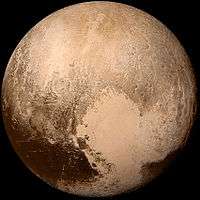2015 FJ345
| DiscoveryMPO 403089 | |
|---|---|
| Discovered by |
first observed by: Mauna Kea |
| Discovery date | 17 March 2015 |
| Designations | |
| MPC designation | 2015 FJ345 |
| distant[1] · TNO[2] · cubewano · detached | |
| Orbital characteristics [2] | |
| Epoch 27 April 2019 (JD 2458600.5) | |
| Uncertainty parameter 4 | |
| Observation arc | 1.13 yr (413 days) |
| Aphelion | 75.068 AU |
| Perihelion | 50.693 AU |
| 62.881 AU | |
| Eccentricity | 0.1938 |
| 499 yr (182,135 days) | |
| 58.73° | |
| 0° 0m 7.2s / day | |
| Inclination | 34.974° |
| 37.88° | |
| 77.40° | |
| Physical characteristics | |
| Dimensions | 100–150 km[3] |
| 25.74[4] | |
| 7.9[1] | |
|
| |
2015 FJ345 is a trans-Neptunian object, located in the scattered disc, the outermost region of the Solar System.[3] It orbits the Sun in a moderate inclined, moderate-eccentricity orbit. The object was discovered in March 2015, by a team of researches led by American astronomer Scott S. Sheppard of the Carnegie Institution for Science.
Discovery and naming
2015 FJ345 was discovered on 17 March 2015. It was discovered by astronomers led by Scott Sheppard of the Carnegie Institution for Science as part of the survey for distant solar system objects beyond the Kuiper Belt edge using the new wide-field cameras on the Subaru and Cerro Tololo Inter-American Observatory (CTIO) telescopes.
Orbit
Considered a detached object,[5][6] 2015 FJ345 is particularly unusual as it has an unusually circular orbit for a scattered-disc object (SDO). Although it is thought that traditional scattered-disc objects have been ejected into their current orbits by gravitational interactions with Neptune, the low eccentricity of its orbit and the distance of its perihelion (SDOs generally have highly eccentric orbits and perihelia less than 38 AU) seems hard to reconcile with such celestial mechanics. This has led to some uncertainty as to the current theoretical understanding of the outer Solar System. The theories include close stellar passages, unseen planet/rogue planets/planetary embryos in the early Kuiper belt, and resonance interaction with an outward-migrating Neptune. The Kozai mechanism is capable of transferring orbital eccentricity to a higher inclination.[7] It is in a 3:1 resonance to Neptune. It seems to belong to the same group as 2004 XR190.
Size
2015 FJ345 has a diameter estimated at around 150 kilometres (93 mi), roughly a quarter the size of 2004 XR190 which is estimated at around 500 kilometres (310 mi), roughly a quarter the size of Pluto, and it orbits between 50 and 76 AU from the Sun.
References
- 1 2 "2015 FJ345". Minor Planet Center. Retrieved 2018-10-09.
- 1 2 "JPL Small-Body Database Browser: 2015 FJ345" (2015-01-24 last obs.). Jet Propulsion Laboratory. Retrieved 28 February 2017.
- 1 2 Scott. S. Sheppard; Chadwick Trujillo; David J. Tholen (2015). "Beyond the Kuiper Belt Edge: New High Perihelion Trans-Neptunian Objects With Moderate Semi-major Axes and Eccentricities". The Astrophysical Journal Letters. 825/1: L13. arXiv:1606.02294. Bibcode:2006ApJ...640L..83A. doi:10.3847/2041-8205. (Discovery paper)
- ↑ "AstDys 2015 FJ345 Ephemerides". Department of Mathematics, University of Pisa, Italy. Retrieved 2018-10-09.
- ↑ Jewitt, David, Morbidelli, Alessandro, & Rauer, Heike. (2007). Trans-Neptunian Objects and Comets: Saas-Fee Advanced Course 35. Swiss Society for Astrophysics and Astronomy. Berlin: Springer. ISBN 3-540-71957-1.
- ↑ Lykawka, Patryk Sofia & Mukai, Tadashi. (2007). Dynamical classification of trans-neptunian objects: Probing their origin, evolution, and interrelation. Icarus Volume 189, Issue 1, July, Pages 213–232. doi:10.1016/j.icarus.2007.01.001.
- ↑ R. L. Allen; B. Gladman (2006). "Discovery of a low-eccentricity, high-inclination Kuiper belt object at 58 AU". The Astrophysical Journal. 640: L83. arXiv:astro-ph/0512430. Bibcode:2006ApJ...640L..83A. doi:10.1086/503098. (Discovery paper)
_(cropped).jpg)
